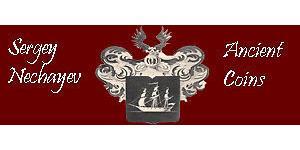1 Stater
[ 3862] PAMPHYLIA: ASPENDUS Silver Stater (30mm, 10.84 gm.) Pamphylia, Aspendos. c.370-333 B.C. Reference: SNG Cop 230. SNG von Aulock 4567. Two naked athletes, wrestling, grasping each other by the arms; FI between them, all within circle of dots. Slinger standing right, about to discharge his sling; triskeles above club before; ΕΣΤFEΔΙY behind, within square of dots. Provided with certificate of authenticity. CERTIFIED AUTHENTIC by Sergey Nechayev, PhD - Numismatic Expert Aspendos or Aspendus (Greek Άσπενδος) was an ancient Greco-Roman city in Antalya province of Turkey. It is located 7 kilometres (4.3 mi) northeast of central Serik. History Aspendus was an ancient city in Pamphylia, Asia Minor, located about 25 miles (40 km) east of the modern city of Antalya, Turkey. It was situated on the Eurymedon River about 10 miles (16 km) inland from the Mediterranean Sea; it shared a border with, and was hostile to, Side. According to later tradition, the (originally non-Greek) city was founded around 1000 B.C. by Greeks who may have come from Argos. The wide range of its coinage throughout the ancient world indicates that, in the 5th century B.C., Aspendus had become the most important city in Pamphylia. At that time the Eurymedon River was navigable as far as Aspendus, and the city derived great wealth from a trade in salt, oil, and wool. In 333 B.C. Aspendus paid Alexander the Great a levy to avoid being garrisoned, but it ignored its agreements with him and later was occupied. In 190 B.C. the city surrendered to the Romans, who later pillaged it of its artistic treasures. Toward the end of the Roman period the city began a decline that continued throughout Byzantine times. Roman structures Aspendos is known for having the best-preserved theater of antiquity. With a diameter of 96 meters (315 ft), the theater provided seating for 7,000. The theater was built in 155 by the Greek architect Zenon, a native of the city, during the rule of Marcus Aurelius. It was periodically repaired by the Seljuks, who used it as a caravansary, and in the 13th century the stage building was converted into a palace by the Seljuqs of Rum. In order to keep with Hellenistic traditions, a small part of the theater was built so that it leaned against the hill where the Citadel (Acropolis) stood, while the remainder was built on vaulted arches. The high stage served to seemingly isolate the audience from the rest of the world. The scaenae frons or backdrop, has remained intact. The 8.1 meter (27 ft) sloping reflective wooden ceiling over the stage has been lost over time. Post holes for 58 masts are found in the upper level of the theater. These masts supported a velarium or awning that could be pulled over the audience to provide shade. Until recently the theatre was still in use for concerts, festivals and events. Due to some damage caused by fitting modern theatrical equipment during these events the Turkish authorities have suspended further shows. A new modern facility known as Aspendos Arena has been constructed nearby to continue the tradition of open air theatre in Aspendos. Nearby stand the remains of a basilica, agora, nymphaeum and 15 kilometers (9.3 mi) of Roman aqueduct. The Roman Eurymedon Bridge, reconstructed in the 13th century, is also in the vicinity. Coinage Aspendos was one of the earliest cities to mint coins. It began issuing coinage around 500 B.C., first staters and later drachmas; "the hoplite on the obverse represents the soldiery for which Aspendus was famous in antiquity," the reverse frequently depicts a triskelion. The legend appears on early coins as the abbreviation ΕΣ or ΕΣΤϜΕ; later coinage has ΕΣΤϜΕΔΙΙΥΣ, the adjective from ΕΣΤϜΕΔΥΣ (Estwedus), the local name of the city. The city's numismatic history extends from archaic Greek to late Roman times. Payment & Shipping: Will accept payments via PayPal. = MM_contentVersion;
}
else if (navigator.userAgent && navigator.userAgent.indexOf("MSI ...
type to read more

|
Posted by:
anonymous 2015-08-18 |
|
||
|
||
|
||
You may be interested in following coins
2024-04-22
- Historical Coin Prices
2024-04-22
- New coin is added to 1 Histamenon Byzantine Empire (330-1453) Gold Michael VII Do ...
1 Histamenon Byzantine Empire (330-1453) Gold Michael VII Do ...
group has 6 coins / 4 prices
⇑
Byzanz Michael VII. Ducas 1071-1078. Histamenon Nomisma. 4,40 g. Brustbild Christi / Brustbild des Herrschers von vorn mit Labarum und Kreuzglobus. Sear 1868, Friedberg 264. GOLD. Vorzüglich +
You may be interested in ...

-600-300-klUKbzbiCPwAAAFPLvWr70MN.jpg)

-300-150-igYKbzbi6QkAAAFLNg36Agfa.jpg)
 English
English





-300-150-MXzBwcI0KsgAAAEmEfE6TOhH.jpg)






